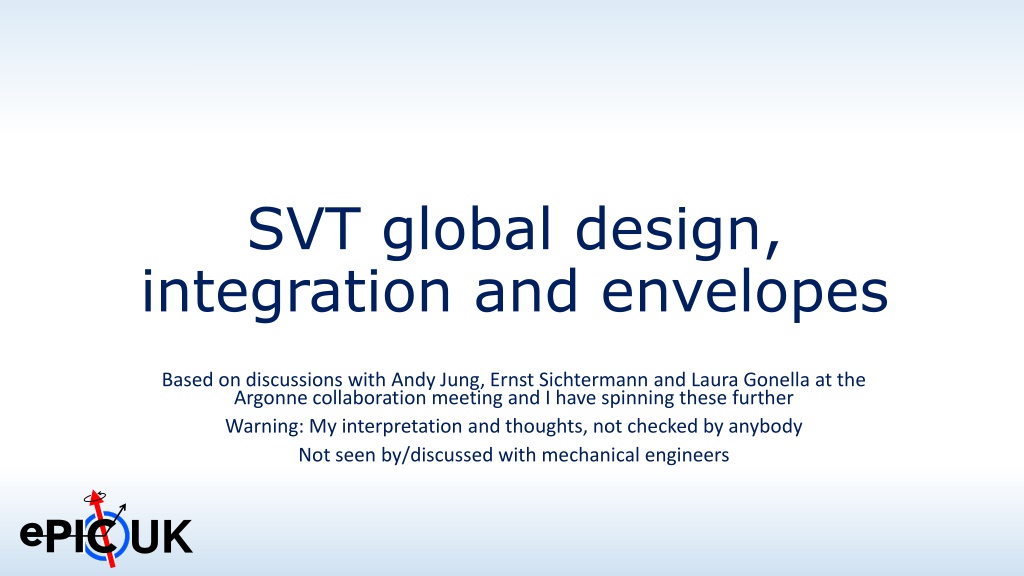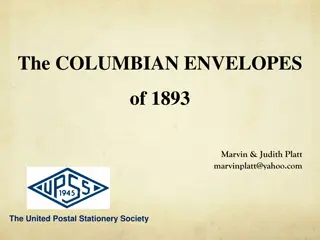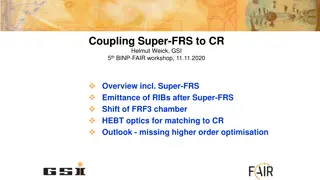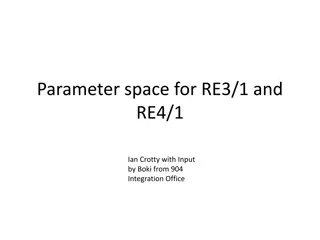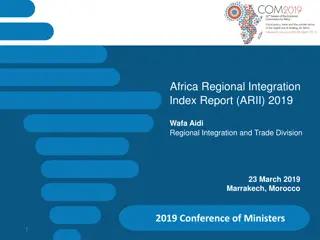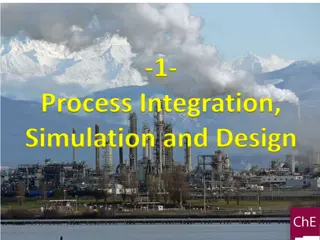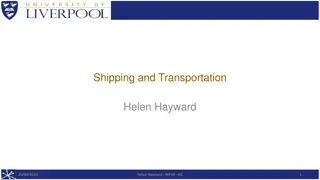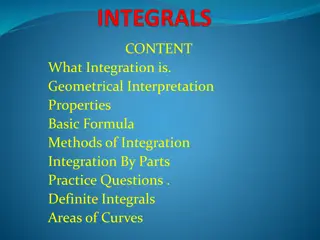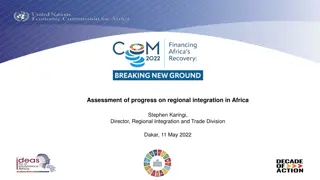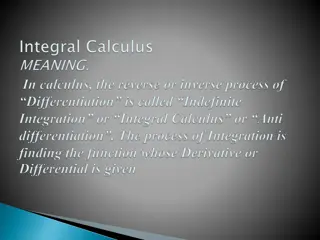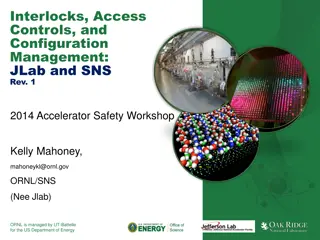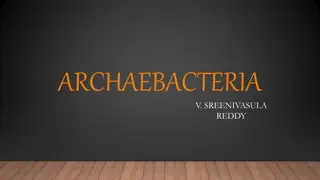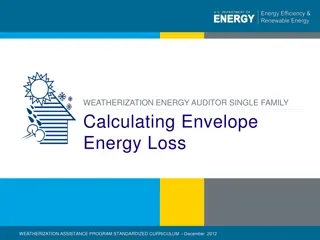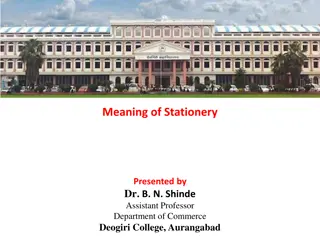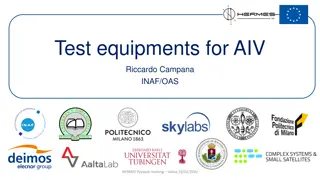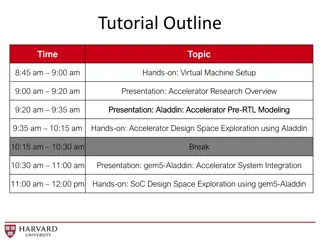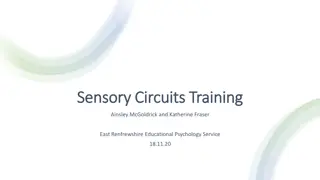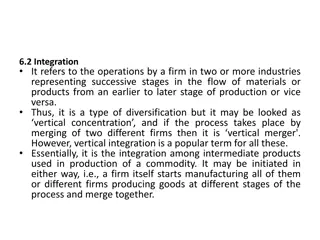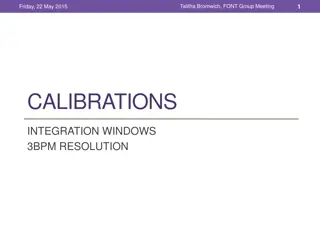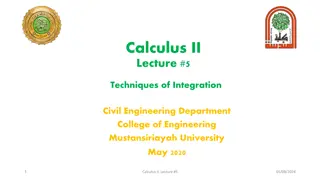SVT Global Design Integration and Envelopes Overview
SVT (Silicon Vertex Tracker) is divided into six parts split in the xy-plane to allow clam-shelling of the conical beampipe, with detailed descriptions of the Central SVT, Electron Endcap, and Hadron Endcap sections. The design includes carbon fiber half-shells, support cones, and integration steps for assembling the different components. Envelopes with suggested dimensions and details on the central section are provided. The focus is on structural elements, dead regions, and critical material accumulation aspects. This comprehensive overview showcases the proposed design and integration process for the SVT project.
Download Presentation

Please find below an Image/Link to download the presentation.
The content on the website is provided AS IS for your information and personal use only. It may not be sold, licensed, or shared on other websites without obtaining consent from the author. Download presentation by click this link. If you encounter any issues during the download, it is possible that the publisher has removed the file from their server.
E N D
Presentation Transcript
SVT global design, integration and envelopes Based on discussions with Andy Jung, Ernst Sichtermann and Laura Gonella at the Argonne collaboration meeting and I have spinning these further Warning: My interpretation and thoughts, not checked by anybody Not seen by/discussed with mechanical engineers UK
Overall design UK The SVT will be divided into six parts Split in xy plane to allow for clam-shelling of conical beampipe Not clear yet whether left/right or top/bottom In length it will be divided into Central SVT (CS), comprising IB, OB and 2 small and 2 large disks Electron Endcap (EEC), containing 3 large disks Hadron Endcap (HEC), containing 3 large disks Each of these parts will be contained in a carbon fibre half-shell Corresponding half-shells will be connected on the long edges once the segments are clam-shelled around the beam pipe MPGDs and TOF will be sliding over this assembly (because I guess the beam pipe will be long?...) 2
Central section UK Within the central section the main structural elements are the support cones They support all the local supports and the IB package They contain co-cured air ducts They hold all services and the RDOs and control boards Angular region covered by the support cone is considered dead region for the tracking, i.e. it is understood that there will be an accumulation of material This should be projective (pointing to the centre of the SVT) The dead cone should be as narrow as possible Material in the electron direction is more critical than in the hadron direction e h 3
UK CS envelopes with suggested dimensions 580.00 mm 580.00 mm 430.00 mm 275.00 mm 430.00 mm 275.00 mm Dimensions indicative only! To be revised after proper design 134.50 mm 131.50 mm 20 mm 20 mm 460.00 mm 440.00 mm 395.00 mm 10 mm 274.24 mm 240.00 mm 225.39 mm 3 mm 122.31 mm 5 mm 5 mm Envelope of support cones and services (electrical, optical and air) 10 mm clearance at end of local supports RDOs IB D0 D0 L3 L3 4 L4, D1 L4, D1
Central SVT integration UK In the UK: 1. Half-cones for one CS are mounted on a backing frame on the split plane side 2. Support frame is mounted rotatable on an assembly structure 3. L3 staves are mounted, FPC and RDOs are placed on the outer side of the support cones At this point L3 staves can be operated and checked 4. L4 staves are mounted, FPC are routed through the support cone and RDOs are placed on the inner rim of the support cones At this point L4 staves can be operated and checked 5. Carbon fibre half-shell is mounted on outer rim of support cones At BNL: 6. Backing frame is removed 7. IB is inserted and mounted between support cones, FPCs are and RDOs are mounted on outside of support cones At this point IB layers can be operated and checked 8. Small disks are mounted, FPCs and RDOs are mounted on outside of support cone At this point the small disks can be operated and checked 9. Large disks are mounted, FPCs are mounted on outside of support cone and RDOs on inner rim of support cone At this point the large disks can be operated and checked Half cone Backing frame 5
IB integration UK Support cone could be split into inner cone with IB layers and outer cone Inner cone should be large enough to hold IB RDOs and control boards Connection by flange This flange would also need to connect the air ducts for the IB IB would be inserted into outer cones as one piece Connections can be made from end Disks will be mounted afterwards Relative placement of IB and OB could be controlled by backing frame(s) To minimize material L0/L1 services would become radial as quickly as possible If wire-bonding requires FPCs to come of axially, then a 90 (or more) bend is required L4 RDOs L3 RDOs IB RDOs e h Flange inner/outer cone 6 6
OB integration UK Staves will be mounted individually onto support cones During this process we will need some kind of a handling strongback How to connect to stave? Vacuum? RDOs will be close to staves Straightforward for L3 For L4 the FPC will need to be routed through holes in the support cones Still thinking about the couplings for the air cooling For integration it would be good to have air ducts from the inside pointing out But then we would have to route the air duct through the narrow path between L3/4 and the disks On one side we could feed axially On the other from the outside in? The we possibly need a small bridging section that is added after the stave is mounted We might find that castellated layout is better than tiled Only need to remove max 3 to replace a stave during commissioning L4 RDOs L3 RDOs e h Air? 7
Assumptions on RDOs UK Data RDO: VTRX+: 20 10 mm2 Power: 4 Tx Module 100 mW on 2.5 V Connections Solder connection to FPC Solder connection to power cable from supply (Iin, Iout)? Solder connection for RDO (VTRX+) power? Connector for control lines Assume board size 30 15 mm2, total power 100 mW Control board VTRX+: 20 10 mm2 Power: 2 Tx & 1 Rx Module 150 mW on 2.5 V lpGBT: 9 9mm2 Power: 500 mW @ 5.12 Gb/s (overkill?) Connections Solder connection to 8 sets of control lines or spider FPC Solder connection for power for CB? Assume board size 40 15 mm2, total power 650 mW These power numbers are not high I suspect we will get away without any active cooling for these Active cooling of the VRTX+ would be difficult (they are plugged into RDO) e-side p-side Data Control Data Control L0 - - 24 4 L1 - - 32 6 L2 - - 80 14 L3 46 6 46 6 L4 148 20 148 20 Sum 194 26 330 50 Power [W] 19.4 16.9 33 32.5 Total power [W] 36.3 65.5 These numbers have been adjusted to match splits in the detector 8
Cooling UK I suspect the only way to get the air flow needed is by bringing in compressed air, and venting the air into the SVT volume and let it flow out unguided through the service ducts If we come in with compressed air, we need some pressure regulation before we distribute to local supports Still needs to be investigated, but I suspect that these pressure regulators (high pressure, high flow) will be substantial (most commonly brass, although maybe there are PEEK ones?...), so Also, high pressure lines probably need to be stainless steel Likely that pressure regulators will be on the outside perimeter Will require low-pressure air ducts to local supports Air ducts should be co-cured into the support cone The exact cross-section of these ducts is not yet known, but it will be smaller than the cross-section of the flow channels in the local supports If we vent into the SVT volume need appropriate diffusers Arrows indicate possible location of pressure regulators 9 e h
Service management UK All services break at the end of the SVT in a patchpanel VRTX+ is plugable with fibre ribbon (pigtail) ending in MT connector For data ideally would get 3:1 harnesses that have an MT12 at the patch panel For the control if we stay mixed a 4:1 harness would give us again MT12 If we split Tx and Rx, then 6:1 would result in one MT12 (Tx) and one MT8 (Rx) with two dark fibres, but this seems not very practical Maximum pigtail length (for IB) ~1.6 m Arrows indicate possible location of service patch panels e h 10
